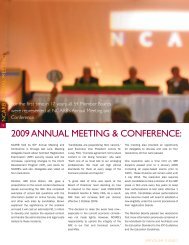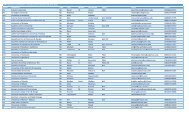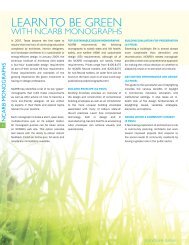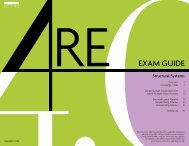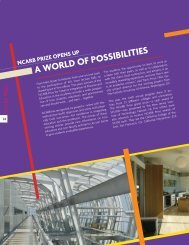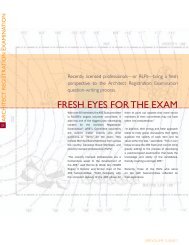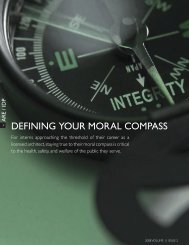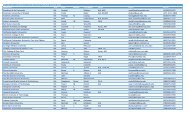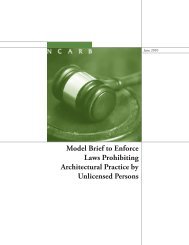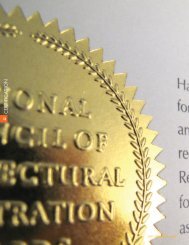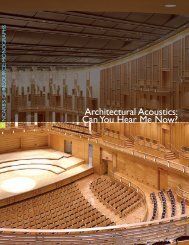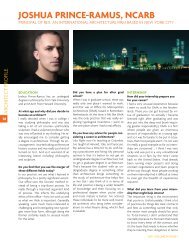NCARB Looks at Exam Security
NCARB Looks at Exam Security
NCARB Looks at Exam Security
You also want an ePaper? Increase the reach of your titles
YUMPU automatically turns print PDFs into web optimized ePapers that Google loves.
ARCHITECT REGISTRATION EXAMINATION<br />
4<br />
A quiet phenomenon has begun to take shape in computer-based<br />
test centers and Internet ch<strong>at</strong> rooms<br />
across the United St<strong>at</strong>es: A small but growing number<br />
of candid<strong>at</strong>es are willfully <strong>at</strong>tempting to circumvent<br />
established guidelines surrounding exam security by<br />
dissemin<strong>at</strong>ing test content. Candid<strong>at</strong>es for the<br />
Architect Registr<strong>at</strong>ion <strong>Exam</strong>in<strong>at</strong>ion (ARE) are<br />
no exception.<br />
<strong>NCARB</strong> <strong>Looks</strong> <strong>at</strong> <strong>Exam</strong> <strong>Security</strong><br />
by Stephen Nutt,AIA<br />
Inappropri<strong>at</strong>e behavior among some ARE<br />
candid<strong>at</strong>es, if left unchecked, will have both<br />
short- and long-term effects on the exam as<br />
well as the architecture profession in general.<br />
In order to address such activity, <strong>NCARB</strong> has<br />
identified five c<strong>at</strong>egories of suspect candid<strong>at</strong>e<br />
behavior:<br />
■ unauthorized access to m<strong>at</strong>erials;<br />
■ presence of unauthorized devices in<br />
the testing room;<br />
■ unauthorized written m<strong>at</strong>erials;<br />
■ use of unauthorized devices or<br />
m<strong>at</strong>erials; and<br />
■ dissemin<strong>at</strong>ion of exam content.<br />
All five c<strong>at</strong>egories have been observed while<br />
candid<strong>at</strong>es are taking exam divisions in<br />
Prometric test centers; all are identified as<br />
viol<strong>at</strong>ing “Test Center Regul<strong>at</strong>ions,” which<br />
are clearly described in the most recent edition<br />
of the ARE Guidelines Version 3.0.<br />
Candid<strong>at</strong>es engaging in the sharing of exam<br />
content—a viol<strong>at</strong>ion of the Confidentiality<br />
Agreement they must agree to prior to taking<br />
a division—can be found in a number of ARErel<strong>at</strong>ed<br />
“ch<strong>at</strong> rooms” th<strong>at</strong> popul<strong>at</strong>e the<br />
Internet.<br />
Once such behavior is identified and fully<br />
investig<strong>at</strong>ed, <strong>NCARB</strong> most likely will impose a<br />
sanction on the candid<strong>at</strong>e. Sanctions may<br />
take the form of immedi<strong>at</strong>e dismissal from<br />
the test center to cancell<strong>at</strong>ion of the current<br />
test score to suspension of future test eligibilities.<br />
The more egregious the behavior, the<br />
more punitive the sanction. Candid<strong>at</strong>es also<br />
may face disciplinary action <strong>at</strong> the st<strong>at</strong>e level<br />
th<strong>at</strong> goes beyond th<strong>at</strong> handed down by<br />
<strong>NCARB</strong>.<br />
UNAUTHORIZED ACCESS TO MATERIALS<br />
One of the more common security breaches<br />
observed in test centers are <strong>at</strong>tempts to<br />
access personal notes, belongings, or other<br />
reference m<strong>at</strong>erials during unscheduled<br />
breaks.<br />
Bringing any study m<strong>at</strong>erials to the test cen-<br />
2005VOLUME 8 ISSUE 1
ter is, in and of itself, grounds for dismissal.<br />
The ARE Guidelines Version 3.0 clearly st<strong>at</strong>es<br />
th<strong>at</strong> “[n]o reference m<strong>at</strong>erial may be brought<br />
into the testing room or accessed from your<br />
locker during the administr<strong>at</strong>ion of your<br />
exam.”<br />
These actions are flagrant viol<strong>at</strong>ions of the<br />
established “Test Center Regul<strong>at</strong>ions” (see<br />
sidebar). Test center administr<strong>at</strong>ors are<br />
required to file a report of any infraction for<br />
review and action by Thomson Prometric and<br />
<strong>NCARB</strong>. If candid<strong>at</strong>es are caught, they may<br />
be immedi<strong>at</strong>ely dismissed from the test center,<br />
and their scores may be cancelled. No<br />
refunds are provided in these situ<strong>at</strong>ions.<br />
PRESENCE AND USE OF<br />
UNAUTHORIZED DEVICES<br />
Candid<strong>at</strong>es also have been observed bringing<br />
unsanctioned electronic devices—among<br />
them, cell phones, personal digital assistants<br />
(PDA’s), audio/video recording aides, and foreign<br />
language transl<strong>at</strong>ors—into the testing<br />
room. Whether in an “on” or “off” position,<br />
such actions clearly viol<strong>at</strong>e “Test Center<br />
Regul<strong>at</strong>ions,” which st<strong>at</strong>e, “Communic<strong>at</strong>ion<br />
devices, such as personal digital assistants,<br />
pagers, and cellular telephones, are not<br />
allowed in the testing room."<br />
A candid<strong>at</strong>e should place their electronic<br />
items in a test center locker for the dur<strong>at</strong>ion<br />
of the testing period. At no time should such<br />
devices be present in the testing room nor<br />
should they be accessed during breaks.<br />
Despite such rules, candid<strong>at</strong>es take advantage<br />
of unscheduled breaks in order to<br />
access their lockers, place calls, and/or<br />
check voice-mail messages.<br />
Once again, candid<strong>at</strong>es caught with unauthorized<br />
electronic devices may be subject to a<br />
number of <strong>NCARB</strong>-rel<strong>at</strong>ed sanctions, including<br />
dismissal from the test center and cancell<strong>at</strong>ion<br />
of their scores. Items also may be<br />
inspected by test center personnel.<br />
Inch-pound calcul<strong>at</strong>ors also are making their<br />
way into the testing room in viol<strong>at</strong>ion of the<br />
rule th<strong>at</strong> only allows for non-programmable,<br />
non-communic<strong>at</strong>ing, non-printing calcul<strong>at</strong>ors.<br />
A new “on-screen” calcul<strong>at</strong>or—accessed via a<br />
a pull-down menu—will be reintroduced into<br />
the exam in the future. At th<strong>at</strong> point, no calcul<strong>at</strong>ors<br />
will be allowed in the testing room.<br />
PRESENCE AND USE OF UNAUTHORIZED<br />
WRITTEN MATERIALS<br />
Less common is the discovery of actual notes<br />
or reference m<strong>at</strong>erials in the testing room. In<br />
such cases, candid<strong>at</strong>es are caught with<br />
unauthorized m<strong>at</strong>erials in the test room while<br />
taking a division. This is not a m<strong>at</strong>ter of peeking<br />
<strong>at</strong> notes during a scheduled or unscheduled<br />
break; r<strong>at</strong>her, it is any type of notes with<br />
specific details to aid or assist in completing<br />
the exam. In such situ<strong>at</strong>ions, all unauthorized<br />
written m<strong>at</strong>erials found in the testing room<br />
will be collected and destroyed—no questions<br />
asked and no exceptions.<br />
While rare, such incidents have occurred in<br />
the past with candid<strong>at</strong>es providing interesting<br />
explan<strong>at</strong>ions for the presence of reference<br />
m<strong>at</strong>erials in the testing environment.<br />
One candid<strong>at</strong>e explained th<strong>at</strong> his “che<strong>at</strong><br />
sheet” <strong>at</strong>tached itself to his shoe while he<br />
was <strong>at</strong>tempting to complete some lastminute<br />
studying in the waiting room. He did<br />
not realize th<strong>at</strong> the paper had slipped into his<br />
shoe while making his way into the test room.<br />
All test centers utilize a closed-circuit<br />
audio/video recording system th<strong>at</strong> captures<br />
all activity in the testing room. These tapes<br />
are reviewed if any irregularities or suspicious<br />
behavior is observed. Fortun<strong>at</strong>ely for<br />
this candid<strong>at</strong>e, test center personnel did not<br />
observe him using the m<strong>at</strong>erial. Instead, they<br />
found the “che<strong>at</strong> sheet” on the floor during<br />
the exam and then removed it. Had the candid<strong>at</strong>e<br />
been actively observed referring to the<br />
unauthorized m<strong>at</strong>erial—or if the video monitoring<br />
system had recorded obvious use of<br />
the “che<strong>at</strong> sheet”—he would have faced a<br />
much more severe sanction.<br />
<strong>NCARB</strong>’s Board of Directors, in conjunction<br />
with the Committees on <strong>Exam</strong>in<strong>at</strong>ion and<br />
Professional Conduct, is formul<strong>at</strong>ing disciplinary<br />
responses for such situ<strong>at</strong>ions, including<br />
immedi<strong>at</strong>e dismissal from the test center,<br />
cancelled scores, and an extended testing<br />
suspension.<br />
Test Center Regul<strong>at</strong>ions<br />
To ensure th<strong>at</strong> all ARE divisions are<br />
administered under comparable<br />
conditions to th<strong>at</strong> of other candid<strong>at</strong>es<br />
and th<strong>at</strong> the results represent<br />
a fair and accur<strong>at</strong>e<br />
measurement, it is necessary to<br />
maintain a standardized testing<br />
environment.<br />
ARE candid<strong>at</strong>es must adhere to<br />
the following regul<strong>at</strong>ions when sitting<br />
for the exam:<br />
■ Communic<strong>at</strong>ion devices, such<br />
as personal digital assistants,<br />
pagers, and cellular telephones,<br />
are not allowed in the testing<br />
room.<br />
■ E<strong>at</strong>ing, drinking, or use of<br />
tobacco is not allowed in the<br />
test center.<br />
■ Papers, books, food, or purses<br />
are not allowed in the testing<br />
room.<br />
■ ONLY non-programmable, noncommunic<strong>at</strong>ing,<br />
non-printing calcul<strong>at</strong>ors<br />
are allowed. The test<br />
center administr<strong>at</strong>or reserves<br />
the right to refuse the use of<br />
any other calcul<strong>at</strong>ors and is not<br />
responsible for providing a<br />
replacement calcul<strong>at</strong>or.<br />
■ You may not leave the testing<br />
room without the test center<br />
administr<strong>at</strong>or’s permission.<br />
■ You must present your identific<strong>at</strong>ion<br />
each time you enter the<br />
testing room.<br />
■ No reference m<strong>at</strong>erial may be<br />
brought into the testing room or<br />
accessed from your locker during<br />
the administr<strong>at</strong>ion of your<br />
exam. On-screen reference<br />
m<strong>at</strong>erial is accessible during the<br />
General Structures division and<br />
the Mechanical & Electrical<br />
Systems division.<br />
ARCHITECT REGISTRATION EXAMINATION<br />
5<br />
DIRECT CONNECTION
ARCHITECT REGISTRATION EXAMINATION<br />
6<br />
When Is Sharing Inform<strong>at</strong>ion<br />
About the ARE Acceptable?<br />
DISSEMINATION OF EXAM CONTENT<br />
Of the five types of suspect behavior identified<br />
by <strong>NCARB</strong>, the knowing dissemin<strong>at</strong>ion of<br />
exam content is the most serious and most<br />
damaging. In such situ<strong>at</strong>ions, candid<strong>at</strong>es<br />
write down as many partial questions and<br />
answers as they can remember shortly after<br />
taking a multiple-choice division. An electronic<br />
version of this “brain dumping” is then<br />
posted onto an ARE-rel<strong>at</strong>ed online forum,<br />
where fellow candid<strong>at</strong>es can anonymously<br />
download the file and pass it onto other willing<br />
parties.<br />
Unfortun<strong>at</strong>ely, two instances of this extreme<br />
lack of judgment on the part of candid<strong>at</strong>es<br />
were discovered in 2005. Both situ<strong>at</strong>ions<br />
were swiftly and successfully dealt with<br />
through the cooper<strong>at</strong>ion of <strong>NCARB</strong> staff, legal<br />
counsel, and <strong>NCARB</strong>’s test development consultant,<br />
Thomson Prometric. Based on decisions<br />
made by the Council’s Board of<br />
Directors, both individuals had their respective<br />
scores cancelled. They also have been<br />
suspended for three years from taking any<br />
ARE divisions.<br />
ARE-rel<strong>at</strong>ed online forums are legitim<strong>at</strong>e<br />
resources for candid<strong>at</strong>es, and in no way does<br />
<strong>NCARB</strong> wish to termin<strong>at</strong>e these communities.<br />
However, problems arise when such forums<br />
become the vehicle through which exam content<br />
is relayed. <strong>NCARB</strong> is not trying to elimin<strong>at</strong>e<br />
friendly discourse among exam candid<strong>at</strong>es. A<br />
potential strength of Internet-based convers<strong>at</strong>ions<br />
is their ability to build communities among parties<br />
who wish to help one another.<br />
<strong>NCARB</strong>’s interest in protecting exam content<br />
is expressly covered by the Confidentiality<br />
Agreement. While all candid<strong>at</strong>es pledge to<br />
abide by the agreement prior to taking an<br />
ARE division, it seems to be of little significance<br />
to those who share such details and to<br />
those who partake in its availability.<br />
Perhaps a “disconnect” of sorts is evident in<br />
such cases. For some, sharing exam content<br />
within a close group of friends or via the<br />
Internet may not be considered to be che<strong>at</strong>ing.<br />
After all, it is not a “traditional” means<br />
of che<strong>at</strong>ing such as hidden notes or the use<br />
of unauthorized devices.<br />
However, such actions have far-reaching consequences.<br />
Not only does the intentional dissemin<strong>at</strong>ion<br />
of exam content viol<strong>at</strong>e <strong>NCARB</strong>’s<br />
Confidentiality Agreement, it also viol<strong>at</strong>es<br />
federal st<strong>at</strong>ues protecting copyrighted m<strong>at</strong>erial.<br />
There is no acceptable way of sharing<br />
ARE questions and/or answers, be they<br />
remembered word-for-word or paraphrased.<br />
Candid<strong>at</strong>es are encouraged to share ideas and<br />
str<strong>at</strong>egies for completing all ARE divisions, including<br />
which division to take first or last; which study<br />
m<strong>at</strong>erials are most helpful; which test centers are<br />
most amenable; and how frequently to test.<br />
Other acceptable suggestions include:<br />
■ “Be sure to answer all questions.”<br />
■ “Skip over and return to questions th<strong>at</strong> are<br />
taking too much time.”<br />
Web hosts on whose forums such inform<strong>at</strong>ion<br />
appears also are viol<strong>at</strong>ing the Digital<br />
Millennium Copyright Act (DMCA) and expose<br />
themselves to penalty in federal court if content<br />
is not removed. Two web sites already<br />
have complied with <strong>NCARB</strong>’s request to<br />
remove specific exam content from their<br />
forums.<br />
Candid<strong>at</strong>es who knowingly exchange exam<br />
content cre<strong>at</strong>e an unfair advantage over their<br />
peers who do not particip<strong>at</strong>e in such<br />
forums—or who choose not to take part in<br />
such activities. Likewise, there is the possibility<br />
th<strong>at</strong> such inform<strong>at</strong>ion is not wholly accur<strong>at</strong>e.<br />
Candid<strong>at</strong>es should be leery of suspect<br />
advice and content. In fact, <strong>NCARB</strong> staff has<br />
found examples of a candid<strong>at</strong>e promoting<br />
wrong answers. It’s th<strong>at</strong> old cave<strong>at</strong>, upd<strong>at</strong>ed<br />
for the electronic age: Everything you read on<br />
the Internet is not necessarily true.<br />
A Brief History of the ARE<br />
Some ARE candid<strong>at</strong>es question the validity<br />
and need for any type of examin<strong>at</strong>ion process<br />
for architects. They disagree in principle with<br />
the idea th<strong>at</strong> architects should be tested prior<br />
to qualifying for registr<strong>at</strong>ion. After all, these<br />
same candid<strong>at</strong>es usually hold an accredited<br />
degree and have completed the Intern<br />
Development Program (IDP).<br />
<strong>NCARB</strong> in and of itself, did not originally<br />
establish the exam qualific<strong>at</strong>ion. In fact, individual<br />
st<strong>at</strong>e boards of architecture were the<br />
first to identify the need to examine candid<strong>at</strong>es<br />
for architectural licensing (or registr<strong>at</strong>ion).<br />
This effort is firmly grounded in the U.S.<br />
Constitution, which empowers st<strong>at</strong>es to protect<br />
public health, safety, and welfare.<br />
2005 VOLUME 8 ISSUE 1
■ “Mark answers th<strong>at</strong> you are not quite<br />
certain of.”<br />
■ “Be prepared to remember this formula . . .”<br />
■ “Study these contract documents . . . ”<br />
■ “I found this zoom tool very helpful—and the<br />
sketch tools are gre<strong>at</strong> to layout guidelines.”<br />
■ “Know the Practice Program inside and out.”<br />
■ “Pay <strong>at</strong>tention to the passing and failing solutions<br />
and commentary in <strong>NCARB</strong>’s<br />
WHY SUSPECT CANDIDATE<br />
BEHAVIOR IS AN ISSUE<br />
If candid<strong>at</strong>es continue to circumvent the<br />
established guidelines protecting ARE content,<br />
<strong>at</strong> least three long-term effects most<br />
likely will occur:<br />
■ continued delivery of ARE divisions will<br />
be interrupted,<br />
■ the integrity of the exam will be undermined,<br />
and<br />
■ the protection of public health, safety,<br />
and welfare will be compromised.<br />
Che<strong>at</strong>ing’s Effect on <strong>Exam</strong> Development and<br />
Delivery<br />
If candid<strong>at</strong>e che<strong>at</strong>ing behaviors continue, the<br />
administr<strong>at</strong>ion of the ARE will be neg<strong>at</strong>ively<br />
affected. For example, the delivery of divisions<br />
th<strong>at</strong> have been breached may be termin<strong>at</strong>ed<br />
until new content can be developed<br />
and introduced. In turn, committing<br />
resources to such efforts will lead to higher<br />
exam fees.<br />
ARE Study Guides Version 3.0.”<br />
■ “Take General Structures and L<strong>at</strong>eral Forces<br />
concurrently.”<br />
■ “Pace yourself while studying and testing.”<br />
■ “Establish a testing schedule and stick to it.”<br />
■ “Set-up a study group with co-workers, former<br />
classm<strong>at</strong>es, and/or fellow candid<strong>at</strong>es.”<br />
There also is a possibility th<strong>at</strong> the model of a<br />
computerized exam will have to be rethought<br />
should incidents continue. Th<strong>at</strong> is, suspect<br />
candid<strong>at</strong>e behavior thre<strong>at</strong>ens <strong>NCARB</strong>’s ability<br />
to offer the ARE <strong>at</strong> the convenience of candid<strong>at</strong>es.<br />
On-demand testing seemingly is a<br />
no-brainer in our technologically advanced<br />
times. Yet, when it leads to compromising<br />
behavior among some candid<strong>at</strong>es, a new<br />
model and/or new administr<strong>at</strong>ion methods<br />
may have to be considered. For example, limited<br />
testing windows for each division may<br />
have to be introduced, severely curtailing the<br />
flexibility now enjoyed by all candid<strong>at</strong>es.<br />
Che<strong>at</strong>ing’s Effect on <strong>Exam</strong> Integrity<br />
More broadly, che<strong>at</strong>ing undermines the validity<br />
of the ARE and compromises the registr<strong>at</strong>ion<br />
process. If a division is breached, st<strong>at</strong>e<br />
registr<strong>at</strong>ion boards can no longer rely on the<br />
ARE as a true measure of competence or<br />
level of knowledge. This clearly would result<br />
in the potential licensing of architects who<br />
may be ill-equipped for their professional<br />
responsibilities. As <strong>NCARB</strong>’s legal counsel<br />
has noted, “People who in fact accur<strong>at</strong>ely<br />
■ General descriptions of exam content:<br />
“There were more code questions than I<br />
expected.” (No specific exam content is<br />
revealed. Paraphrasing exam content is<br />
never acceptable.)<br />
Candid<strong>at</strong>es must be willing to “police” their<br />
own. Otherwise, <strong>NCARB</strong> will be forced to<br />
actively monitor, challenge, and remove<br />
offending content from online forums.<br />
publicize ARE questions not only viol<strong>at</strong>e copyright<br />
laws and risk severe sanctions from<br />
<strong>NCARB</strong> and its member boards, but also<br />
demean their profession by helping unqualified<br />
persons pass the ARE.”<br />
Che<strong>at</strong>ing’s Effect on the Core Mission<br />
of <strong>NCARB</strong><br />
It is well known th<strong>at</strong> <strong>NCARB</strong> and its member<br />
boards count as one of their primary responsibilities<br />
the protection of the public health,<br />
safety, and welfare. By establishing a set of<br />
standards all architects are asked to meet,<br />
<strong>NCARB</strong> member boards essentially are trying<br />
to guarantee the qualific<strong>at</strong>ions of architects<br />
who practice in their jurisdictions. Because<br />
the ARE plays an integral role in determining<br />
such standards, any efforts to undermine its<br />
ability to fairly gauge a candid<strong>at</strong>e’s knowledge<br />
and skills will prove to be detrimental<br />
both to the profession and to the public.<br />
ARCHITECT REGISTRATION EXAMINATION<br />
7<br />
At first, the hodgepodge of st<strong>at</strong>e-level<br />
exams—with their respective specific<strong>at</strong>ions,<br />
questions, and passing standards—seriously<br />
imperiled uniformity among the boards; neg<strong>at</strong>ively<br />
affected the likelihood of an effective<br />
reciprocity system (needed to encourage<br />
interst<strong>at</strong>e practice, a hallmark of architecture);<br />
and provided little equal public protection<br />
n<strong>at</strong>ionwide.<br />
Working through <strong>NCARB</strong>, member boards<br />
standardized their various exam approaches.<br />
After several iter<strong>at</strong>ions, the computer-based<br />
ARE was introduced in 1997; it has been a<br />
40-year long odyssey to reach this milestone.<br />
(See page 10 for more inform<strong>at</strong>ion about the<br />
40th anniversary of <strong>NCARB</strong> exams.)<br />
DIRECT CONNECTION
ARCHITECT REGISTRATION EXAMINATION<br />
8<br />
Grounds for Dismissal<br />
From a Test Center<br />
An ARE candid<strong>at</strong>e who engages in<br />
misconduct and/or does not heed<br />
the test center administr<strong>at</strong>or’s<br />
warning to discontinue inappropri<strong>at</strong>e<br />
behavior may be dismissed<br />
from the test center or have examin<strong>at</strong>ion<br />
results voided. <strong>Exam</strong>ples of<br />
misconduct include:<br />
■ Failing to follow the instructions<br />
of the test center administr<strong>at</strong>or.<br />
■ Viol<strong>at</strong>ing the test center<br />
regul<strong>at</strong>ions.<br />
■ Cre<strong>at</strong>ing a disturbance of any<br />
kind.<br />
■ Giving or receiving assistance of<br />
any kind.<br />
■ Using any unauthorized references<br />
or aides.<br />
■ Removing or <strong>at</strong>tempting to<br />
remove examin<strong>at</strong>ion questions<br />
and/or responses (in any form<strong>at</strong>)<br />
or notes about the examin<strong>at</strong>ion<br />
from the testing room.<br />
■ Removing or <strong>at</strong>tempting to<br />
remove scr<strong>at</strong>ch paper from the<br />
test center.<br />
■ Attempting to take the examin<strong>at</strong>ion<br />
for someone else.<br />
■ Tampering with the oper<strong>at</strong>ion of<br />
the computer or <strong>at</strong>tempting to<br />
use it for any function other than<br />
taking the examin<strong>at</strong>ion.<br />
■ Leaving the testing room without<br />
permission.<br />
■ Using electronic communic<strong>at</strong>ions<br />
equipment such as personal<br />
digital assistants, cellular telephones,<br />
pagers, etc.<br />
■ Bringing any study m<strong>at</strong>erials<br />
(e.g., textbooks, classroom<br />
notes, crib sheets) to the testing<br />
center. The test center administr<strong>at</strong>or<br />
may report anyone who<br />
brings study m<strong>at</strong>erials to the<br />
testing center for appropri<strong>at</strong>e<br />
action.<br />
RESPONDING TO SUSPECT<br />
CANDIDATE BEHAVIOR<br />
As previously mentioned, <strong>NCARB</strong> can<br />
respond to suspect candid<strong>at</strong>e behavior in a<br />
number of different ways. Sanctions vary<br />
depending on the type of infraction and may<br />
include:<br />
■ Immedi<strong>at</strong>e dismissal from the test<br />
center<br />
■ Cancell<strong>at</strong>ion of current test score(s)<br />
■ Voiding of previous test scores(s)<br />
■ Suspension of future test eligibilities<br />
(up to three years)<br />
■ Delayed or denied registr<strong>at</strong>ion<br />
■ Delayed or denied certific<strong>at</strong>ion<br />
Two ARE candid<strong>at</strong>es already have experienced<br />
the cancell<strong>at</strong>ion of test scores, the<br />
extended suspension of all testing privileges<br />
(three years), and possible fines—not to mention<br />
the reimbursement of legal fees required<br />
to respond to the che<strong>at</strong>ing incidents.<br />
Additional disciplinary actions by their st<strong>at</strong>e<br />
boards have yet to be determined.<br />
If a candid<strong>at</strong>e is disciplined and their testing<br />
eligibilities are suspended, the new ARE Five<br />
Year Rolling Clock—set to debut January 1,<br />
2006—will remain in effect. Basically, the<br />
clock keeps ticking, which may have a detrimental<br />
effect on a candid<strong>at</strong>e found to be in<br />
viol<strong>at</strong>ion of the Confidentiality Agreement l<strong>at</strong>e<br />
in their eligibility period. Regardless of the<br />
length of disciplinary action, a candid<strong>at</strong>e<br />
would lose credit for any previously passed<br />
division(s) if a security-breach suspension<br />
keeps them from completing the ARE within a<br />
five-year period.<br />
The Council also is considering a series of<br />
changes th<strong>at</strong> could be implemented on the<br />
test center level. For example, one possible<br />
change would elimin<strong>at</strong>e candid<strong>at</strong>e access to<br />
lockers. <strong>NCARB</strong> already has decided to ban<br />
personal calcul<strong>at</strong>ors beginning as early as<br />
2007. Instead, candid<strong>at</strong>es will use a mousedriven,<br />
on-screen calcul<strong>at</strong>or. This is<br />
one means to cut down on the possibility of<br />
che<strong>at</strong>ing.<br />
HONESTY RULES<br />
In spite of the focus of this article, the majority<br />
of ARE candid<strong>at</strong>es DO NOT che<strong>at</strong>. They, in<br />
fact, take measures to avoid the appearance<br />
of misconduct by following some simple rules<br />
when taking exam divisions, including<br />
■ Leave exam- and work-rel<strong>at</strong>ed m<strong>at</strong>erials<br />
<strong>at</strong> home.<br />
■ Do not take any personal articles to the<br />
test center.<br />
■ Empty all pockets and place items in<br />
the locker.<br />
■ Do not return to the locker until the<br />
exam has been completed.<br />
2005 VOLUME 8 ISSUE 1
■<br />
Return all scr<strong>at</strong>ch paper to test center<br />
personnel.<br />
MOVING FORWARD<br />
Computer-savvy, headstrong, and perhaps<br />
feeling just a bit entitled, the small group of<br />
ARE candid<strong>at</strong>es who knowingly break the<br />
rules have cre<strong>at</strong>ed a phenomenon with both<br />
short- and long-term effects for everyone.<br />
Short-term effects include <strong>NCARB</strong>’s potential<br />
inability to deliver specific portions of the<br />
ARE—a factor th<strong>at</strong> delays registr<strong>at</strong>ion and<br />
advancement for all, and most likely would<br />
lead to an increase in exam fees.<br />
Additionally, one long-term effect on the profession<br />
is clear: Continuing security breaches<br />
will undermine the validity of the exam and<br />
ultim<strong>at</strong>ely compromise the registr<strong>at</strong>ion<br />
process.<br />
Che<strong>at</strong>ing on the ARE—in wh<strong>at</strong>ever form a<br />
candid<strong>at</strong>e chooses—ultim<strong>at</strong>ely endangers<br />
the very public architects are intended to protect.<br />
It’s th<strong>at</strong> simple. When self-interest<br />
trumps personal ethics, as described by<br />
P<strong>at</strong>ricia Keefe, a blogger on the Inform<strong>at</strong>ion<br />
Week web site, serious ramific<strong>at</strong>ions will<br />
result. 1<br />
Currently, the ARE represents the profession’s<br />
best and most comprehensive effort to<br />
assess a candid<strong>at</strong>e’s knowledge, skills, and<br />
abilities to provide independently the various<br />
services required in the practice of architecture.<br />
It is an evolving resource whose value is<br />
constantly sustained by the volunteer efforts<br />
of practicing architects from across the<br />
United St<strong>at</strong>es and Canada. The ARE represents<br />
a tremendous effort of the Council and<br />
its members.<br />
No amount of hand-wringing, however, will<br />
reverse the phenomenon of candid<strong>at</strong>e che<strong>at</strong>ing<br />
until candid<strong>at</strong>es themselves decide to<br />
make a change. In a recent article about the<br />
rise in che<strong>at</strong>ing, published in Penn St<strong>at</strong>e<br />
University’s The Penn St<strong>at</strong>er, Management<br />
Professor Linda Klebe Trevino explains,<br />
“. . . [P]eople have to buy into the idea th<strong>at</strong><br />
they want to be in an environment of integrity<br />
and trust, and understand th<strong>at</strong> you only get<br />
to live in th<strong>at</strong> kind of environment if everybody<br />
takes responsibility for it.” 2 DC<br />
1<br />
Keefe, P<strong>at</strong>ricia. “Editor’s Note: Into the Ethical Breach.” Inform<strong>at</strong>ion Week (www.inform<strong>at</strong>ionweek.com). 2 Saulnier, Beth. “So Tempting.” The Penn St<strong>at</strong>er (March/April 2005): 49.<br />
Guidelines for Suspect Candid<strong>at</strong>e Behavior<br />
Level 1: Unauthorized Access to M<strong>at</strong>erials<br />
Personal effects and m<strong>at</strong>erials placed in lockers ONLY can be accessed during a<br />
SCHEDULED break. A report will be filed identifying any candid<strong>at</strong>e caught accessing a<br />
locker during an UNSCHEDULED break. The consequences are:<br />
■ Completion of report by test center administr<strong>at</strong>or.<br />
■ Candid<strong>at</strong>e is warned and instructed to return immedi<strong>at</strong>ely to the testing room to<br />
complete test.<br />
■ Letter of misconduct is sent to candid<strong>at</strong>e notifying him/her of inappropri<strong>at</strong>e behavior.<br />
■ Copy of letter is provided to candid<strong>at</strong>e’s registr<strong>at</strong>ion board.<br />
Level 2: Presence of Unauthorized Devices in Testing Room<br />
Discovery in the testing room of any unauthorized device, whether in the “on” or “off”<br />
position. Except for persons testing under specific conditions rel<strong>at</strong>ed to a disability and<br />
scientific, non-programmable, non-communic<strong>at</strong>ing, non-printing calcul<strong>at</strong>ors (which may<br />
be used in the testing room), no other devices are permitted to be in the testing room.<br />
This includes but is not limited to items such as cellular phones, pagers, personal digital<br />
assistants, audio/video recording devices, language transl<strong>at</strong>ors, etc. The consequences<br />
are:<br />
■ Inspection of device by test center administr<strong>at</strong>or.<br />
■ Immedi<strong>at</strong>e dismissal from the test center.<br />
■ Cancell<strong>at</strong>ion of score for the division.<br />
■ Following a review of the m<strong>at</strong>ter by staff, suspension of test eligibility for all divisions<br />
for SIX MONTHS from d<strong>at</strong>e of test administr<strong>at</strong>ion.<br />
■ Notific<strong>at</strong>ion of action by the Council will be sent to the candid<strong>at</strong>e’s registr<strong>at</strong>ion board for<br />
further independent disciplinary action, if any, as determined by the candid<strong>at</strong>e’s board.<br />
Level 3: Written M<strong>at</strong>erial<br />
Discovery of written m<strong>at</strong>erial in the testing room, including m<strong>at</strong>erial in electronic<br />
devices. This includes but is not limited to items such as answer keys, notes, and<br />
formulae; no written m<strong>at</strong>erial is permitted in the testing room whether or not rel<strong>at</strong>ed to<br />
the ARE. The consequences are:<br />
■ Confisc<strong>at</strong>ion of non-electronic m<strong>at</strong>erial by test center administr<strong>at</strong>or.<br />
■ Immedi<strong>at</strong>e dismissal from the test center.<br />
■ Cancell<strong>at</strong>ion of score for the division.<br />
■ Following a review of the m<strong>at</strong>ter by <strong>NCARB</strong>’s Committee on Professional Conduct, suspension<br />
of test eligibility for all divisions for ONE YEAR from d<strong>at</strong>e of test administr<strong>at</strong>ion.<br />
■ Notific<strong>at</strong>ion of action by the Council will be sent to the candid<strong>at</strong>e’s registr<strong>at</strong>ion board for<br />
further independent disciplinary action, if any, as determined by the candid<strong>at</strong>e’s board.<br />
Level 4: Use of Unauthorized Devices or M<strong>at</strong>erials<br />
Observ<strong>at</strong>ion of the use of any unauthorized devices or m<strong>at</strong>erials in the testing room will<br />
conclusively be presumed to be for purposes of assistance on the test. The consequences<br />
are:<br />
■ Cancell<strong>at</strong>ion of score for the division.<br />
■ Immedi<strong>at</strong>e dismissal from the test center.<br />
■ Following a review of the m<strong>at</strong>ter by <strong>NCARB</strong>’s Committee on Professional Conduct,<br />
suspension of test eligibility for all divisions for up to THREE YEARS from d<strong>at</strong>e of test<br />
administr<strong>at</strong>ion or such longer period as may be warranted in exceptional<br />
circumstances.<br />
■ Notific<strong>at</strong>ion of action by the Council will be sent to the candid<strong>at</strong>e’s registr<strong>at</strong>ion board for<br />
further independent disciplinary action, if any, as determined by the candid<strong>at</strong>e’s board.<br />
Level 5: Dissemin<strong>at</strong>ion of Content<br />
Distribution by the Internet or otherwise to any other person of any test question and/or<br />
alleged answer. This includes <strong>at</strong>tempted recording in the testing room of test content by<br />
any camera or audio device or any <strong>at</strong>tempted dissemin<strong>at</strong>ion following the test including<br />
by paraphrasing any question from memory. The consequences are:<br />
■ Cancell<strong>at</strong>ion of score(s) for the division(s) dissemin<strong>at</strong>ed and any subsequent<br />
division(s) taken prior to the end of any period of test eligibility suspension.<br />
■ Following a review of the m<strong>at</strong>ter by <strong>NCARB</strong>’s Committee on Professional Conduct,<br />
suspension of test eligibility for all divisions for up to THREE YEARS from d<strong>at</strong>e of discovery<br />
of dissemin<strong>at</strong>ion or such longer period as may be warranted in exceptional circumstances.<br />
■ Notific<strong>at</strong>ion of action by the Council will be sent to the candid<strong>at</strong>e’s registr<strong>at</strong>ion board for<br />
further independent disciplinary action, if any, as determined by the candid<strong>at</strong>e’s board.<br />
■ Where <strong>NCARB</strong> pursues legal action, candid<strong>at</strong>e will be responsible for all of <strong>NCARB</strong>’s<br />
costs and damages.<br />
ARCHITECT REGISTRATION EXAMINATION<br />
9<br />
DIRECT CONNECTION



